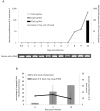Differential expression of three members of the multidomain adhesion CCp family in Babesia bigemina, Babesia bovis and Theileria equi
- PMID: 23844089
- PMCID: PMC3701008
- DOI: 10.1371/journal.pone.0067765
Differential expression of three members of the multidomain adhesion CCp family in Babesia bigemina, Babesia bovis and Theileria equi
Abstract
Members of the CCp protein family have been previously described to be expressed on gametocytes of apicomplexan Plasmodium parasites. Knocking out Plasmodium CCp genes blocks the development of the parasite in the mosquito vector, making the CCp proteins potential targets for the development of a transmission-blocking vaccine. Apicomplexans Babesia bovis and Babesia bigemina are the causative agents of bovine babesiosis, and apicomplexan Theileria equi causes equine piroplasmosis. Bovine babesiosis and equine piroplasmosis are the most economically important parasite diseases that affect worldwide cattle and equine industries, respectively. The recent sequencing of the B. bovis and T. equi genomes has provided the opportunity to identify novel genes involved in parasite biology. Here we characterize three members of the CCp family, named CCp1, CCp2 and CCp3, in B. bigemina, B. bovis and T. equi. Using B. bigemina as an in vitro model, expression of all three CCp genes and proteins was demonstrated in temperature-induced sexual stages. Transcripts for all three CCp genes were found in vivo in blood stages of T. equi, and transcripts for CCp3 were detected in vivo in blood stages of B. bovis. However, no protein expression was detected in T. equi blood stages or B. bovis blood stages or B. bovis tick stages. Collectively, the data demonstrated a differential pattern of expression of three orthologous genes of the multidomain adhesion CCp family by B. bigemina, B. bovis and T. equi. The novel CCp members represent potential targets for innovative approaches to control bovine babesiosis and equine piroplasmosis.
Conflict of interest statement
Figures






Similar articles
-
Assessment of Draxxin® (tulathromycin) as an inhibitor of in vitro growth of Babesia bovis, Babesia bigemina and Theileria equi.Int J Parasitol Drugs Drug Resist. 2018 Aug;8(2):265-270. doi: 10.1016/j.ijpddr.2018.04.004. Epub 2018 Apr 17. Int J Parasitol Drugs Drug Resist. 2018. PMID: 29689532 Free PMC article.
-
Identification of CCp5 and FNPA as Novel Non-canonical Members of the CCp Protein Family in Babesia bovis.Front Vet Sci. 2022 Feb 15;9:833183. doi: 10.3389/fvets.2022.833183. eCollection 2022. Front Vet Sci. 2022. PMID: 35242841 Free PMC article.
-
Comparative Bioinformatics Analysis of Transcription Factor Genes Indicates Conservation of Key Regulatory Domains among Babesia bovis, Babesia microti, and Theileria equi.PLoS Negl Trop Dis. 2016 Nov 10;10(11):e0004983. doi: 10.1371/journal.pntd.0004983. eCollection 2016 Nov. PLoS Negl Trop Dis. 2016. PMID: 27832060 Free PMC article. Review.
-
Endochin-like quinolone-300 and ELQ-316 inhibit Babesia bovis, B. bigemina, B. caballi and Theileria equi.Parasit Vectors. 2020 Dec 3;13(1):606. doi: 10.1186/s13071-020-04487-3. Parasit Vectors. 2020. PMID: 33272316 Free PMC article.
-
Discovering the in vitro potent inhibitors against Babesia and Theileria parasites by repurposing the Malaria Box: A review.Vet Parasitol. 2019 Oct;274:108895. doi: 10.1016/j.vetpar.2019.07.003. Epub 2019 Jul 19. Vet Parasitol. 2019. PMID: 31494399 Review.
Cited by
-
Assessment of Draxxin® (tulathromycin) as an inhibitor of in vitro growth of Babesia bovis, Babesia bigemina and Theileria equi.Int J Parasitol Drugs Drug Resist. 2018 Aug;8(2):265-270. doi: 10.1016/j.ijpddr.2018.04.004. Epub 2018 Apr 17. Int J Parasitol Drugs Drug Resist. 2018. PMID: 29689532 Free PMC article.
-
Identification of CCp5 and FNPA as Novel Non-canonical Members of the CCp Protein Family in Babesia bovis.Front Vet Sci. 2022 Feb 15;9:833183. doi: 10.3389/fvets.2022.833183. eCollection 2022. Front Vet Sci. 2022. PMID: 35242841 Free PMC article.
-
Identification of proteins expressed by Babesia bigemina kinetes.Parasit Vectors. 2019 May 28;12(1):271. doi: 10.1186/s13071-019-3531-7. Parasit Vectors. 2019. PMID: 31138276 Free PMC article.
-
Babesiosis as a potential threat for bovine production in China.Parasit Vectors. 2021 Sep 7;14(1):460. doi: 10.1186/s13071-021-04948-3. Parasit Vectors. 2021. PMID: 34493328 Free PMC article. Review.
-
A framework for signaling throughout the life cycle of Babesia species.Mol Microbiol. 2021 May;115(5):882-890. doi: 10.1111/mmi.14650. Epub 2020 Dec 15. Mol Microbiol. 2021. PMID: 33274587 Free PMC article. Review.
References
-
- Bishop R, Musoke A, Morzaria S, Gardner M, Nene V (2004) Theileria: intracellular protozoan parasites of wild and domestic ruminants transmitted by ixodid ticks. Parasitol 129: S271–S283. - PubMed
-
- Hunfeld KP, Hildebrandt A, Gray JS (2008) Babesiosis: recent insights into an ancient disease. Int J Parasitol 38: 1219–1237. - PubMed
-
- Mehlhorn H, Schein E (1984) The piroplasm: Life cycle and sexual stages. Adv Parasitol 23: 37–103. - PubMed
-
- Delrieu I, Waller CC, Mota MM, Grainger M, Langhorne J, et al. (2002) PSLAP, a protein with multiple adhesive motifs, is expressed in Plasmodium falciparum gametocytes. Mol Biochem Parasitol 121: 11–20. - PubMed
Publication types
MeSH terms
Substances
LinkOut - more resources
Full Text Sources
Other Literature Sources

